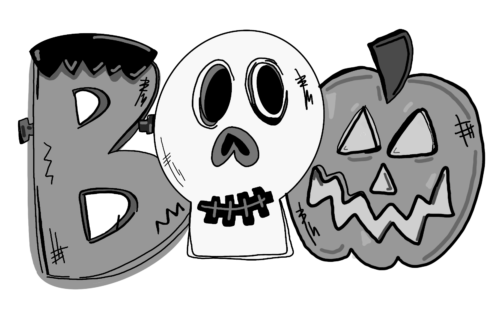Trick or treat, smell my feet, give me something good to eat! Some readers may read this little jingle with a bit of confusion or even disgust, but for me, this jingle takes me back to elementary school, to the gummy smiles of chocolate-stained faces and the crinkle of cheap polyester costumes.
Trick or treat. These two words are meant to encapsulate our consumerized notion of Halloween. Yet most people, when they think of Halloween, think exclusively of plastic bowls full of CVS candy or elaborate costumes ready for a night out. In other words, we think only of the “treat” component.
Whatever happened to the trick? Personally, I’ve never encountered it before. In the 19th century, Halloween began to evolve from the Celtic tradition of All Hallow’s Eve, a day when the boundary between the living and the dead became thin. Pranksters, sometimes known as “belsnicklers,” would rattle windows or frighten small children as they roamed from house to house. As a result, homeowners might offer candy or treats at their doors to dissuade the belsnicklers. In the 1950s, the suburbanization of America made it easier for children to roam from door to door. The rise of merchandising and the Halloween industry fueled mass-produced costumes, and the rest is history. “Trick-ing” fell out of favor, likely because most five-year-olds don’t have the capacity to frighten a regular household as an alternative to not getting a Reese’s.
To bring the spirit of belsnickeling and mischief onto campus, I considered pranking a few classmates. I was ready to go around and see how easy it was to prank Harvard students. Some ideas I had included standing outside Cabot library with a creepy mask in the dark to catch people by surprise, putting fake snakes in the bathroom, or even TP-ing the John Harvard statue in the dead of night (if Securitas didn’t see me).
After pitching these ideas to a few people, however, they reminded me that I could get in trouble for vandalism (a good point) and that I had friends going through midterms (also valid). Sitting in the sterile light of Cabot’s basement, staring at Canvas, it felt like the holiday I thought would take me away from my cares launched me straight back into the grind. It seemed all I could do regarding Halloween was brainstorm my costumes and obsess over the “express shipping” button for Amazon.
If I couldn’t trick, I thought maybe I could go trick-or-treating with friends and revisit that hallmark of childhood. I can’t remember the last time I went trick-or-treating—it must have been prior to the pandemic and before I became a teenager. In a 2016 poll by Slate, almost 50% of readers agreed with this choice: that 13 years old is the maximum age to stop trick-or-treating. According to USA Today, some municipalities even have laws prohibiting teenagers over 15 or 16 from trick-or-treating or wearing masks. While these laws align with how most of the American youth redefine Halloween over time, they place a tombstone marker on childhood.
I still enjoy Halloween—going out with my friends to dance the night away in various getups is always a blast. Yet even nights that are supposed to be fun pulse with anxious thoughts like: What will I wear? Do I have enough photos to post on Instagram? What is everyone else doing? Beyond self-consciousness, we students always go out with a touch of awareness that when these few nights of revelry are over, we have essays to write, jobs to apply to, and networking to do. Everything we seem to do nowadays has some real consequences for our futures, and everything is so serious. I envy my 10-year-old self, who had nothing more on her mind on Halloween than how many Sour Patch Kids I could accumulate versus my brother.
Transitioning into college has been such a blast. I’ve met so many amazing friends and loved taking my classes and joining clubs, but it has also made me acutely aware of the looming reality that is adulthood. In just over three years, I will either have some ideas of my job prospects post-graduation or be looking at graduate school. Is it so wrong to still want some of that childhood whimsy in my life?
From final club anxiety on Sidechat to rampant overcommitment stress, it’s clear I’m not the only one who feels this way. We need to take a collective deep breath and let loose. I don’t mean necessarily going on a three-day bender to distract you from the onslaught of midterm grades coming out—but more whimsy, more human connection, more time doing dumb things like belsnickeling without a little voice in the back of our minds telling us whether this is productive or not.
Maybe this comes off a little flat from a freshman who has only been here a month. Maybe I’m just venting off my own stress from my first semester. But maybe we can start to bring a little more “trick” back into our lives.
Caroline Stohrer ’28 (carolinestohrer@college.harvard.edu) plans on being Tricky from Subway Surfers, Raquelle from Barbie, and a pierrot clown for Halloween.

